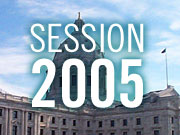Photos
More from MPR
| ||||||||||||||||||||||||||||||||
January 27, 2005
Gov. Tim Pawlenty has proposed a tax credit that he says will help close the achievement gap between white and minority students. Under the plan he first mentioned in this week's budget proposal, businesses would get the credit for funding scholarships that would allow at-risk students in the K-12 public school system to attend private schools.
St. Paul, Minn. — Gov. Pawlenty says the tax credit scholarship fund provides opportunity for students who typically have no choice about where they go to school.
"They are economically challenged, they are socially challenged in many respects, and they are academically challenged," Pawlenty said. "And the statistics as to their performance -- the achievement gap as it relates to caucasian versus students of color -- is chronic, and it's systemic."
The scholarship fund would be built by donations from businesses. The state would give a 50 percent tax credit for contributions up to $200,000. The fund would max out at $4 million annually.
Critics say the money would be better used by schools rather than individual students. Judy Schaubach, president of the Education Minnesota teachers union, says school districts need more help this year. She says they're still hurting from the last Pawlenty budget.
"They cut things like summer school programs, and early childhood programs, and things that help close the achievement gap," Schaubach said. "So it's sort of ironic that we're going to have this separate program, and not fund the basic things that all kids need. We can't have just some kids have this opportunity. All kids need to have the opportunity to succeed."
To be eligible for Pawlenty's program, students would have to show they're academically challenged, and their family's household income couldn't exceed 190 percent of the federal poverty line. That's somewhere between $33,000 and $37,000 a year for a family of four.
Pawlenty says scholarship recipients would be required to show academic progress once enrolled at their school of choice. Pawlenty calls the proposal a modest, constructive way to approach the achievement gap.
"It might work. If it doesn't, we'll scrap it," he said. "But the idea is, we can't sit here and allow another generation of poor, disadvantaged students to basically have the same outcomes that they've had for a long time. So we want to try something new."
Observers call the achievement gap between whites and students of color among the most important public policy issues of our time.
The Minnesota Minority Education Partnership is an organization working to close the gap. Rep. Carlos Mariani, DFL-St. Paul, heads up the partnership. Mariani says the governor's proposal sounds good at first. But, he says the program would cost the state $4 million a year through tax credits, and that has the feel of a back-door voucher system.
"It would be better to have a big discussion about whether Minnesotans want public monies to go to support private K-12 institutions," Mariani said. "I would hope that in pursuit of the bill, that we put that question squarely to the public."
Attorney John Shulman is also skeptical of the governor's plan.
"They know what works, and that's desegregation. And they refuse to allow it to happen," says Shulman, who represented the Minneapolis NAACP and a group of parents in desegregation lawsuits against the state.
The cases were settled five years ago, with the creation of a program that allows disadvantaged Minneapolis students to enroll in neighboring suburban schools. Shulman claims the Pawlenty administration plan won't achieve its goal of closing the achievement gap.
"In fact, they segregate the schools, and then they talk about pilot programs and trying things out," says Shulman. "What do they say to those families and children when things don't quite work out, and they've just wasted that many more years of their lives and lost the educational opportunities."
The business community, the Minnesota Catholic Conference, and organizations raising funds for private schools all say they support Pawlenty's proposal. They say they don't understand why anyone would deny poor students the opportunity to choose where they go to school.






